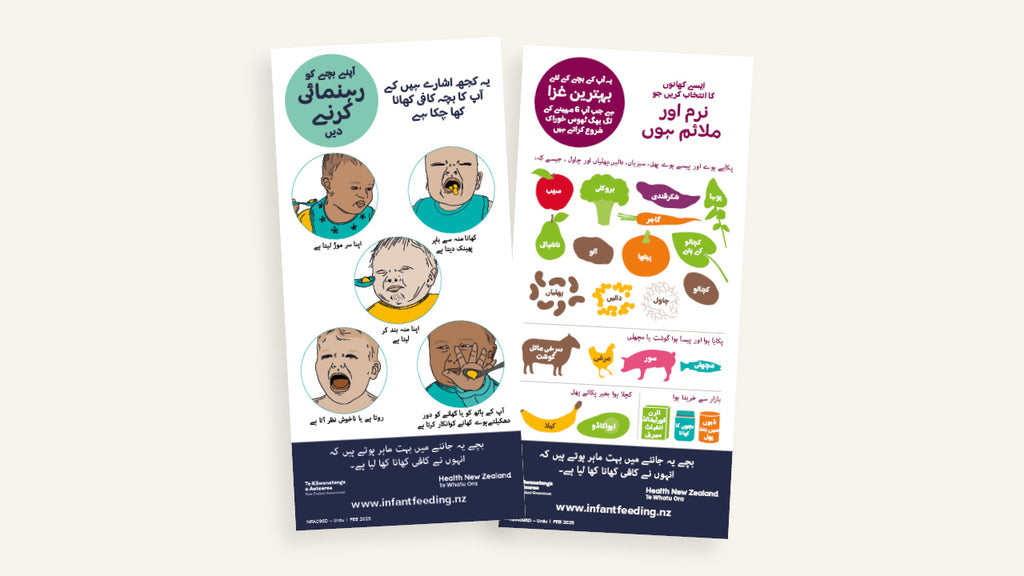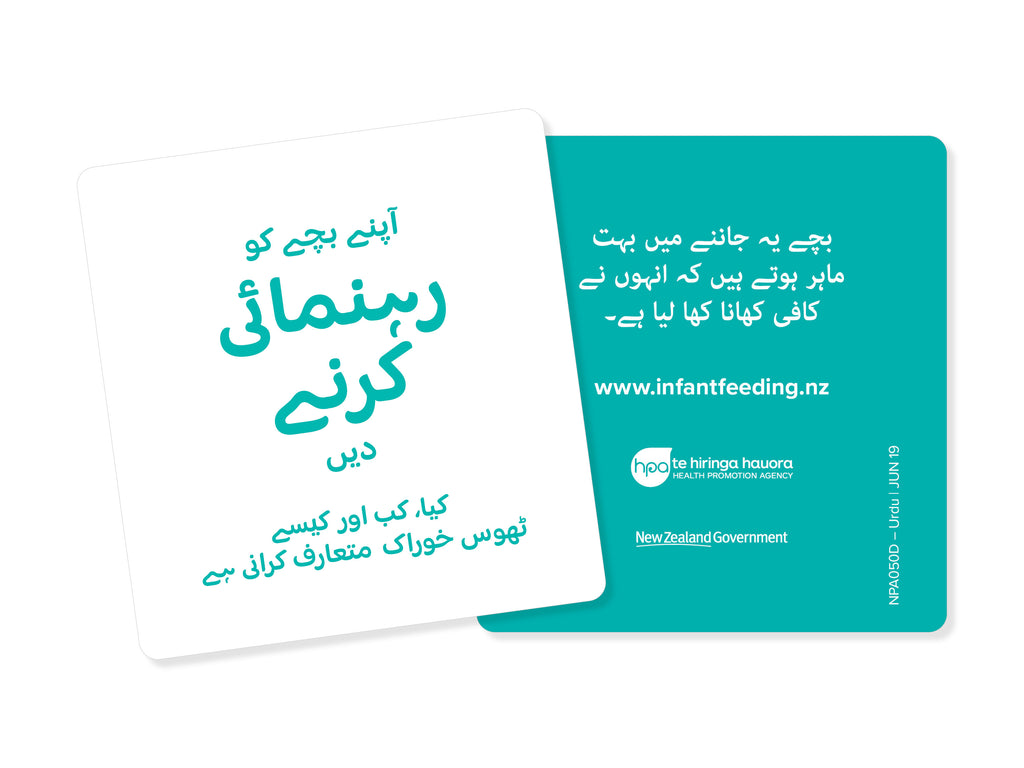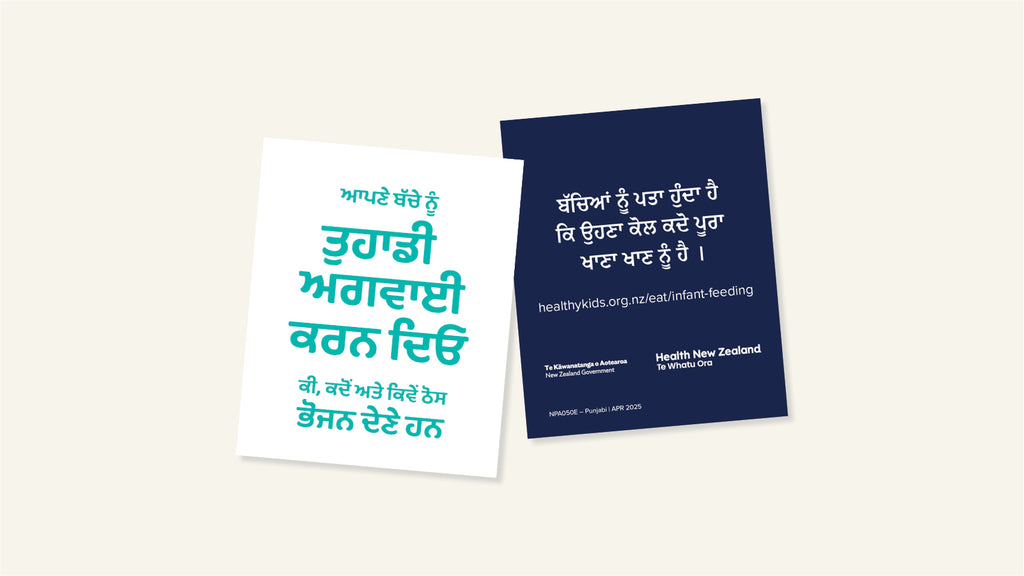Nutrition and Activity
The Health Promotion Directorate provides tools and resources about nutrition and activity to support people who work with families and communities.
Topics of focus include:
- reducing consumption of sugary drinks and promoting water as the drink of choice
- encouraging people to sit less and move more in workplaces
- providing fast, easy and affordable family meal ideas
- encouraging families to be active together
- introducing solids to babies – best foods to try, when and how.
Non-printed resources
We also have many non-printed resources that are available as pdfs. These have been migrated to Healthy Eating and Exercise and Physical Activity topics on the HealthEd website where they will be available for download.
E hea te huka kei roto i tō inu?
This infographic poster shows the amount of sugar in drinks commonly consumed by adults in te reo Māori.
These posters are printed in A3 size.
View E hea te huka kei roto i tō inu? in pdf.
E hia te huka kei roto i te inu a ō tamariki??
This infographic poster shows the amount of sugar in drinks commonly consumed by children in te reo Māori.
These posters are printed in A3 size.
View E hia te huka kei roto i te inu a ō tamariki? in pdf.
Healthy swaps
This poster shows a bright and colourful table of easy food swaps you can make to improve your health.
High-resolution print files are available if you wish to print these at a different size, please email hp-npa@tewhatuora.govt.nz
View Healthy swaps in pdf.
How much sugar is in your drink?
The increasing consumption of sugary drinks is a major factor contributing to the global obesity epidemic. Consuming sugary drinks also increases the risk of other health conditions such as type 2 diabetes, heart disease, gout, and dental decay.
The World Health Organization recommends adults and children should not consume more than 12 teaspoons of sugar a day, or no more than 6 teaspoons for additional health benefits. On average, adults in Aotearoa New Zealand consume about 37 teaspoons of sugar daily through their food and drink intake. Sugary drinks are one of the main sources of the rising sugar intake among children and adults in Aotearoa New Zealand.
In partnership with the New Zealand Dental Association (NZDA), Health New Zealand | Te Whatu Ora developed these infographic posters to illustrate the amount of sugar in drinks commonly consumed by adults in New Zealand, and to promote water as the best choice.
These posters are printed in A3 size. High-resolution print files are available if you wish to print these at a different size, please email hp-npa@tewhatuora.govt.nz.
View How much sugar is in your drink? in pdf
Infant Feeding Fridge Magnets - English (Set of 2, DL)
Order free infant feeding resources about what, when and how to introduce solid foods at around six months of age. These resources are designed to help parents and caregivers recognise the signs of infant readiness to start solid foods and the signs of infants' feeling full.
There is evidence that preserving infants’ natural ability to self-regulate how much food they need can help children grow up to be a healthy weight in adulthood.
A set of fridge magnets for homes – one magnet shows what first foods are best and the other shows infant fullness signs.
View Infant Feeding Fridge Magnets - English (Set of 2, DL) in PDF.
Infant Feeding Fridge Magnets - Hindi (Set of 2, DL)
Order free infant feeding resources about what, when and how to introduce solid foods at around six months of age. These resources are designed to help parents and caregivers recognise the signs of infant readiness to start solid foods and the signs of infants' feeling full.
There is evidence that preserving infants’ natural ability to self-regulate how much food they need can help children grow up to be a healthy weight in adulthood.
A set of fridge magnets for homes – one magnet shows what first foods are best and the other shows infant fullness signs.
Please note: this resource is translated into Hindi.
View Infant Feeding Fridge Magnets - Hindi (Set of 2, DL) in PDF.
Infant Feeding Fridge Magnets - Mandarin (Set of 2, DL)
Order free infant feeding resources about what, when, and how to introduce solid foods at around six months of age. These resources are designed to help parents and caregivers recognise the signs of infant readiness to start solid foods and the signs of infants' feeling full.
There is evidence that preserving infants’ natural ability to self-regulate how much food they need can help children grow up to be a healthy weight in adulthood.
A set of fridge magnets for homes – one magnet shows what first foods are best, and the other shows infant fullness signs.
Please note: this resource is translated into Mandarin.
View a pdf of Infant Feeding Fridge Magnets - Mandarin (Set of 2, DL) here
Infant Feeding Fridge Magnets - Punjabi (Set of 2, DL)
Order free infant feeding resources about what, when and how to introduce solid foods at around six months of age. These resources are designed to help parents and caregivers recognise the signs of infant readiness to start solid foods and the signs of infants' feeling full.
There is evidence that preserving infants’ natural ability to self-regulate how much food they need can help children grow up to be a healthy weight in adulthood.
A set of fridge magnets for homes – one magnet shows what first foods are best and the other shows infant fullness signs.
Please note: this resource is translated into Punjabi.
View Infant Feeding Fridge Magnets - Punjabi (Set of 2, DL) in PDF.
Infant Feeding Fridge Magnets - Te Reo (Set of 2, DL)
Order free infant feeding resources about what, when and how to introduce solid foods at around six months of age. These resources are designed to help parents and caregivers recognise the signs of infant readiness to start solid foods and the signs of infants' feeling full.
There is evidence that preserving infants’ natural ability to self-regulate how much food they need can help children grow up to be a healthy weight in adulthood.
A set of fridge magnets for homes – one magnet shows what first foods are best and the other shows infant fullness signs.
Please note: this resource is translated into Te Reo.
View Infant Feeding Fridge Magnets - Te Reo (Set of 2, DL) in PDF.
Infant Feeding Fridge Magnets - Urdu (Set of 2, DL)
Order free infant feeding resources about what, when and how to introduce solid foods at around six months of age. These resources are designed to help parents and caregivers recognise the signs of infant readiness to start solid foods and the signs of infants' feeling full.
There is evidence that preserving infants’ natural ability to self-regulate how much food they need can help children grow up to be a healthy weight in adulthood.
A set of fridge magnets for homes – one magnet shows what first foods are best and the other shows infant fullness signs.
Please note: this resource is translated into Urdu.
View Infant Feeding Fridge Magnets - Urdu (Set of 2, DL) in PDF.
Infant Feeding Guide Z Card - Korean
Order free infant feeding resources about what, when and how to introduce solid foods at around six months of age. These resources are designed to help parents and caregivers recognise the signs of infant readiness to start solid foods and the signs of infants' feeling full.
There is evidence that preserving infants’ natural ability to self-regulate how much food they need can help children grow up to be a healthy weight in adulthood.
A fold-up guide for parents and caregivers - this is designed as handy reference guide to help parents know when their baby is ready to try solid foods and when their baby has had enough to eat.
Please note: this resource is translated into Korean.
View Infant Feeding Guide Z Card - Korean in PDF.
Infant Feeding Guide Z Card - Mandarin
Order free infant feeding resources about what, when and how to introduce solid foods at around six months of age. These resources are designed to help parents and caregivers recognise the signs of infant readiness to start solid foods and the signs of infants' feeling full.
There is evidence that preserving infants’ natural ability to self-regulate how much food they need can help children grow up to be a healthy weight in adulthood.
A fold-up guide for parents and caregivers - this is designed as handy reference guide to help parents know when their baby is ready to try solid foods and when their baby has had enough to eat.
Please note: this resource is translated into Mandarin.
View Infant Feeding Guide Z Card - Mandarin in PDF.
Infant Feeding Guide Z Card - Te Reo
Order free infant feeding resources about what, when and how to introduce solid foods at around six months of age. These resources are designed to help parents and caregivers recognise the signs of infant readiness to start solid foods and the signs of infants' feeling full.
There is evidence that preserving infants’ natural ability to self-regulate how much food they need can help children grow up to be a healthy weight in adulthood.
A fold-up guide for parents and caregivers - this is designed as handy reference guide to help parents know when their baby is ready to try solid foods and when their baby has had enough to eat.
Please note: this resource is translated into Te Reo.
View Infant Feeding Guide Z Card - Te Reo in PDF.
Infant Feeding Guide Z Card - Urdu
Order free infant feeding resources about what, when and how to introduce solid foods at around six months of age. These resources are designed to help parents and caregivers recognise the signs of infant readiness to start solid foods and the signs of infants' feeling full.
There is evidence that preserving infants’ natural ability to self-regulate how much food they need can help children grow up to be a healthy weight in adulthood.
A fold-up guide for parents and caregivers - this is designed as handy reference guide to help parents know when their baby is ready to try solid foods and when their baby has had enough to eat.
Please note: this resource is translated into Urdu.
View Infant Feeding Guide Z Card - Urdu in PDF.
Infant feeding pull out guide - English
Order free infant feeding resources about what, when and how to introduce solid foods at around six months of age. These resources are designed to help parents and caregivers recognise the signs of infant readiness to start solid foods and the signs of infants' feeling full.
There is evidence that preserving infants’ natural ability to self-regulate how much food they need can help children grow up to be a healthy weight in adulthood.
A fold-up guide for parents and caregivers - this is designed as handy reference guide to help parents know when their baby is ready to try solid foods and when their baby has had enough to eat.
View Infant Feeding Guide Z Card - English in pdf.
Infant Feeding pull out guide - Hindi
Order free infant feeding resources about what, when and how to introduce solid foods at around six months of age. These resources are designed to help parents and caregivers recognise the signs of infant readiness to start solid foods and the signs of infants' feeling full.
There is evidence that preserving infants’ natural ability to self-regulate how much food they need can help children grow up to be a healthy weight in adulthood.
A fold-up guide for parents and caregivers - this is designed as handy reference guide to help parents know when their baby is ready to try solid foods and when their baby has had enough to eat.
Please note: this resource is translated into Hindi
View Infant Feeding Guide Z Card - Hindi in PDF.
Infant Feeding pull out guide - Punjabi
Order free infant feeding resources about what, when and how to introduce solid foods at around six months of age. These resources are designed to help parents and caregivers recognise the signs of infant readiness to start solid foods and the signs of infants' feeling full.
There is evidence that preserving infants’ natural ability to self-regulate how much food they need can help children grow up to be a healthy weight in adulthood.
A fold-up guide for parents and caregivers - this is designed as handy reference guide to help parents know when their baby is ready to try solid foods and when their baby has had enough to eat.
Please note: this resource is translated into Punjabi.
View Infant Feeding Guide Z Card - Punjabi in PDF.
Play Your Best Card - take home pamphlet (Pack of 30 )
This pack of 30 pamphlets are to replenish the Play Your Best Card game and are not intended for use separate from the game.
The pamphlets are to encourage participants to reflect on their conversations after playing Play Your Best Card, a team-based game that encourages teens to have conversations on a range of topics relevant to young people.
You can view and download the game take home pamphlet here.
You can download the game take home pamphlet in a printable A4 format here.
Play Your Best Card – game
This product is only available to schools, kura and those working with young people. Please note: Maximum of two sets per order.
Play Your Best Card is a team-based, facilitated game designed to spark meaningful conversations among teens about real-life situations and challenges. It encourages critical thinking, supports open discussions, and helps raise awareness of youth support organisations.
Facilitation is essential to ensure the game’s purpose is achieved—empowering young people to talk about issues affecting them now or in the future.
Important: Please do not request this game for giveaways, conferences, or events. Due to high production costs, we only distribute it to our intended audience.
Rethink your child's drink?
The increasing consumption of sugary drinks is a major factor contributing to the global obesity epidemic. Consuming sugary drinks also increases the risk of other health conditions such as type 2 diabetes, heart disease, gout and dental decay.
Sugary drinks contribute over a quarter of the total dietary sugar consumed by children in Aotearoa New Zealand. Despite efforts to restrict the availability of sugary drinks in schools, 73% of students were still able to buy sugary drinks on school grounds.
In partnership with the New Zealand Dental Association (NZDA), Te Whatu Ora | Health Promotion developed these infographic posters to illustrate the amount of sugar in drinks commonly consumed by children and young people in Aotearoa New Zealand, and to promote water as the best choice.
These posters are printed in A3 size. High-resolution print files are available if you wish to print these at a different size, please email hp-npa@tewhatuora.govt.nz.
View Rethink your child's drink? in pdf.
Water is the best choice
Water is the best choice - any time, any place, any activity. This A3 poster shows we don’t need sports or energy drinks to fuel a busy day. Display these posters at sports clubs, schools, workplaces and anywhere to promote water as the best choice.
These posters are printed in A3 size. High-resolution print files are available if you wish to print these at a different size, please email hp-npa@tewhatuora.govt.nz.
View Water is the best choice in pdf.




















